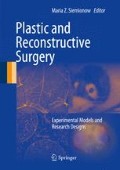Abstract
Extensive trauma can lead to the peripheral nerve transection injury. Further reconstruction can be done with the use of the best method: end-to-end coaptation, if this will not cause tension of the approximated trunks. Larger nerve gaps resulted from tissue loss or degeneration, require additional material for the reconstruction. Ideal material acceptable for nerve engraftment is autologous nerve, however the sources of it are limited. Despite well-established method of full-thickness cable-nerve grafting there is still need for research to improve results of functional nerve restoration following grafting, as well as to increase the amount of neural tissue material suitable for reconstruction.
An experimental rat animal model of the single fascicle graft repair of the sciatic nerve gap, had been developed to evaluate the idea of large nerve defect reconstruction with the lowest possible amount of autologous neural material needed for effective nerve regeneration. In this chapter the scientific rational for the use of single fascicle graft nerve repair, description of its rat animal model and summary of our studies done on this model as well as the review of literature will be presented.
Access this chapter
Tax calculation will be finalised at checkout
Purchases are for personal use only
References
Grabb W-C, Bement S-L, Koepke G-H, Green R-A. Comparison of methods of peripheral nerve suturing in monkeys. Plast Reconstr Surg. 1970;46(1):31–8.
Mackinnon SE, Dellon AL. Surgery of peripheral nerve. New York: Thieme Medical Publishers; 1998.
Miyamoto Y. Experimental studies on repair for peripheral nerves. Effects of tension at suture site on intraneural circulation. Hiroshima J Med Sci. 1979;28:13.
Philipeaux J-M, Vulpian A. Note sur des essays de greffe d’un troncon du nerf lingual entre les deux bouts du nerf hypoglosse, apres excision d’un segment de ce derniernerf. Arch de Physiol Norm et Path Par. 1870;3:618–20.
Albert E. Einige Operationem an Nerven. Wien Med Wochenschr. 1885;26:1285.
Woodall B, Beebe WG. Peripheral nerve reconstruction: a follow-up study of 3,656 world war II injuries. Department of Veterans Affairs Medical Monograph. Washington, DC: US Government Printing Office; 1956.
Seddon H-J. The use of autogenus grafts for repair of large gaps in peripheral nerves. Br J Surg. 1947;3535:151.
Milesi H, Ganglberger J, Berger A. Erfahrungen mit der Microchirurgie peripher Nerven. Chir Plast. 1967;3:47.
Suderland S. The intraneural topography of the radial, median, and ulnar nerves. Brain. 1945;68:243.
Siemionow M, Zielinski M, Meirer R. The single-fascicle method of nerve grafting. Ann Plast Surg. 2004;52(1):72–9.
Scharpf J, Meirer R, Zielinski M, Unsal M, Ramieni P, Nair D, Siemionow M. A novel technique for peripheral nerve repair. Laryngoscope. 2003;113(1):95–101.
de Medinaceli L, Freed W-J. Peripheral nerve reconnection: immediate histologic consequences of distributed mechanical support. Exp Neurol. 1983;81(2):459–68.
Edshage S. Peripheral nerve suture. Acta Chir Scand Suppl. 1964;331:2.
Diao E, Vannuyen T. Techniques for primary nerve repair. Hand Clin. 2000;16:53–66.
Milesi H. Progress in peripheral nerve reconstruction. World J Surg. 1990;14:733–47.
Aguayo AJ. Schwann cell survival in auto-, allo- and xenografts. In: Gorio A, Millesi H, Mingrino S, editors. Post-traumatic peripheral nerve regeneration: experimental basis and clinical implications. New York: Raven; 1981. p. 319–21.
Aguayo AJ, Bray GM. Experimental nerve grafts. In: Jewett D, McCarroll, editors. Nerve repair and regeneration-its clinical and experimental basis. St. Louis: CV Mosby; 1980. p. 68–75.
Aguayo A-J, Charron L, Bray G-M. Potential of Schwann cells from unmyelinated nerves to produce myelin- a quantitative ultrastructural and radioautographic study. J Neurocytol. 1976;5(8):565–73.
Maeda T, Mackinnonn S-E, Best T-J, et al. Regeneration across “stepping-stone” nerve grafts. Brain Res. 1993;618:196–202.
Hall S-M. The effect of inhibiting Schwann cell mitosis on the re-innervation of acellular autografts in the peripheral nervous system of the mouse. Neuropathol Appl Neurobiol. 1986;12(4):401–14.
Demirkan F, Snyder CC, Latifoglu O, Siemionow M. A method of enhancing regeneration of conventionally repaired peripheral nerves. Ann Plast Surg. 1995;34(1):67–72.
Siemionow S, Tetik C, Ozer K, et al. Epineural sleeve neurorraphy: surgical technique and functional results. Ann Plast Surg. 2002;48:281–5.
Millesi H. Techniques for nerve grafting. Hand Clin. 2000;16(1):73–91.
Almgren K-G. Revascularization of free peripheral nerve grafts. An experimental study in the rabbit. Acta Orthop Scand Suppl. 1975;154:1–104.
Bielschowsky M, Unger E. Die Ueberbrueckung grosser Nervenluecken. Beitraege zur Kennetnis der Degeneration and Regeneration peripher Nerven. J Physiol Neurol. 1916-1918;22:267.
Kline DG. Surgical repair of peripheral nerve injury. Muscle Nerve. 1990;13:843–52.
Okuyama N, Nako Y, Takayama S, Toyama Y. Effect of number of fascicle on axonal regeneration in cable grafts. Microsurgery. 2004;24:400–7.
Tzou CH, Aszmann OC, Frey M. Bridging peripheral nerve defects using a single-fascicle nerve graft. Plast Reconstr Surg. 2011;128(4):861–9.
Author information
Authors and Affiliations
Editor information
Editors and Affiliations
Rights and permissions
Copyright information
© 2015 Springer-Verlag London
About this chapter
Cite this chapter
Zielinski, M. (2015). Single Fascicle Graft Repair Model. In: Siemionow, M. (eds) Plastic and Reconstructive Surgery. Springer, London. https://doi.org/10.1007/978-1-4471-6335-0_54
Download citation
DOI: https://doi.org/10.1007/978-1-4471-6335-0_54
Published:
Publisher Name: Springer, London
Print ISBN: 978-1-4471-6334-3
Online ISBN: 978-1-4471-6335-0
eBook Packages: MedicineMedicine (R0)

